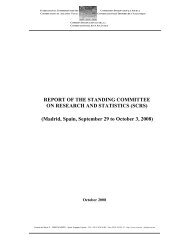SCRS/2002/033 - Iccat
SCRS/2002/033 - Iccat
SCRS/2002/033 - Iccat
Create successful ePaper yourself
Turn your PDF publications into a flip-book with our unique Google optimized e-Paper software.
<strong>SCRS</strong>/<strong>2002</strong>/<strong>033</strong>Col. Vol. Sci. Pap. ICCAT, 55(1): 91-93 (2003)LENGTH AND WEIGHT CONVERSION EQUATIONS FOR BLUEFIN TUNAFROM THE EASTERN MEDITERRANEAN SEAP. Peristeraki 1 , G. Tserpes 1 , C. Koutsikopoulos 2 , G. Katselis 2 and A. Kallianiotis 3SUMMARYThis paper presents empirical estimators (equations) for conversion among different measuresof size (length or weight) for bluefin tuna from the eastern Mediterranean Sea. These equationsthat allow conversions from upper jaw fork length to gilled-gutted weight and from pectoral finforklength to dressed weight, are based on data from the Greek fisheries exploiting the Ionian,Aegean and Levantine seas.RÉSUMÉLe présent document fournit des estimateurs empiriques (équations) pour la conversion au seinde diverses mesures de taille (longueur ou poids) du thon rouge de l’est de la Méditerranée.Ces équations qui permettent des conversions de la longueur maxillaire supérieur-fourche enpoids éviscéré et sans branchie et de la longueur nageoire pectorale-fourche en poids manipulésont fondées sur les données des pêcheries grecques qui exploitent les mers ionienne, Egée etdu Levant.RESUMENEste documento presenta estimadores empíricos (ecuaciones) para las conversiones entrediferentes mediciones de talla (longitud y peso) para el atún rojo del Mediterráneo oriental.Estas ecuaciones que permiten realizar conversiones de longitud de mandíbula inferior a pesoeviscerado y sin agallas y desde longitud de aleta pectoral a horquilla a pesco canal se basanen datos de las pesquerías griegas que explotan los mares de Levante, Egeo y Jónico.KEY WORDSLength-weight relationships, bluefin tuna1. INTRODUCTIONBluefin tuna (Thunnus thynnus L.) catches are landed in different condition (dressed, gilled–guttede.t.c) in the various Mediterranean fisheries. As the necessary for fisheries monitoring sizemeasurements (length, weight) are usually obtained from landed fish, there is a need for conversionequations among different measures that would allow size comparisons among areas, fisheries etc.Previously developed length-weight relationships allow conversions from fork length (FL) to roundweight (RWT) and they are based on data from east Atlantic (Rey and Cort, unpublished; cited inICCAT 1990) and Mediterranean landings (Arena, unpublished; cited in ICCAT 1990; Srour, 1993).The present work intends to present conversion factors for the Mediterranean bluefin tuna, based ondata obtained from the Greek fisheries, which exploit the eastern Mediterranean Sea. Estimators wereobtained for converting upper jaw-fork length (UJFL) to gilled-gutted weight (GWT) and pectoral finforklength (PFFL) to dressed weight (DWT).1 Institute of Marine Biology of Crete, Iraklion, Greece. e-mail:notap@imbc.gr.2 University of Patras, Dept. of Biology, Patras, Greece.3 Fisheries Research Institute of Kavala, Nea Peramos, Greece.91
2. MATERIALS AND METHODSA total of 226 UJFL (cm) – GWT (kg) and 341 PFFL (cm) – DWT (kg) measurements wereobtained from the various Greek bluefin tuna fisheries operating in the Aegean, Ionian and LevantineSeas in 2000 and 2001. The term “dressed weight” refers to gilled and gutted animals without head.The commonly used, for describing length-weight relationships, exponential model (W = a L b ) wasfitted to the observations and the model parameters were estimated by means of traditional leastsquares regression.3. RESULTS AND DISCUSSIONTables 1 and 2 present details and parameter estimates of the fitted models. Graphic presentationsof the estimated length-weight relationships are given in Figures 1 and 2. A search in the relevantliterature failed to detect any similar length-weight relationships for the east Atlantic- Mediterraneanbluefin tuna stock as the existing equations refer only to the fork length-round weight relationship(Rey and Cort, unpublished; cited in ICCAT 1990; Arena, unpublished; cited in ICCAT 1990; Srour,1993). ICCAT scientists suggest the use of specific month equations for the west-Atlantic stock(ICCAT, 1990) as the fish condition factor varies within the year due to various physiological andenvironmental reasons. It is normal to assume that the same would be valid for the east Atlantic-Mediterranean stock. Unfortunately, the available data set was rather short; thus did not allowcomparisons among months and the development of month specific length-weight relationships. Untilfurther data are obtained the present equations should be considered as preliminary and used in theabsence of time specific models.4. ACKNOWLEDGEMENTSThis study has been carried out with the financial assistance of the European Commission (DGFISH - Study Projects 98/045 and 00/044)LITERATURE CITEDICCAT, 1990. Field Manual for Statistics and Sampling Atlantic Tunas and Tuna-like Fishes. 3 rdedition, Madrid, Spain.SROUR, A., 1993. Relation taille-poids et composition en tailles des captures du thon rouge (Thunnusthynnus) de la Mediterranee Marocaine. ICCAT, Coll. Vol. Sci. Pap. XL(1): 155-156.Table 1. Coefficients of the equation GWT=aUJFL, b , used for predicting bluefin tuna GWT (kg) from UJFL(cm) for the eastern Mediterranean Sea.Sample size Length range (cm) R 2 a b226 73-282 0.91 0.0001 2.5984Table 2. Coefficients of the equation DWT=aPFFL, b , used for predicting bluefin tuna DWT (kg) from PFFL(cm) for the eastern Mediterranean Sea.Sample size Length range (cm) R 2 a b341 71-175 0.92 0.0003 2.532292
GGW (kg)4504003503002502001501005000 50 100 150 200 250 300UJFL (cm)Figure 1. UJFL-GWT relationship for bluefin tuna from the Eastern Mediterranean Sea.DW (kg)1801601401201008060402000 50 100 150 200PFFL (cm)Figure 2. PFFL-DWT relationship for bluefin tuna from the Eastern Mediterranean Sea.93
















